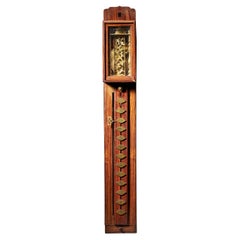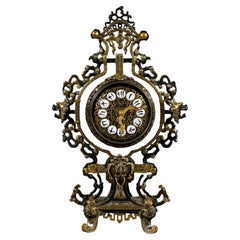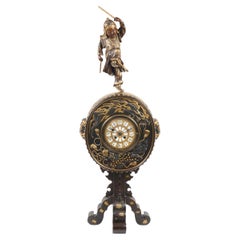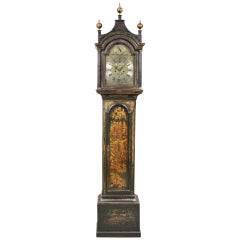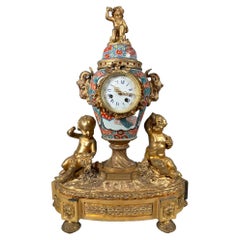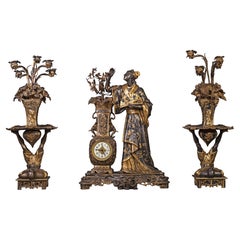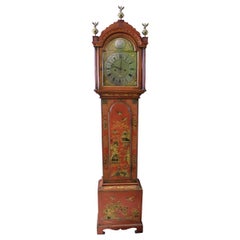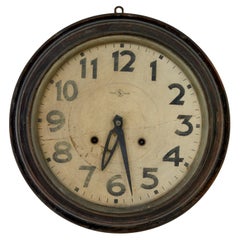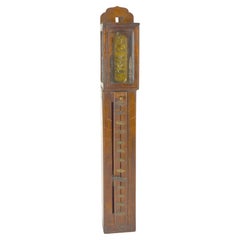Japanese Antique Clocks
Early 19th Century Japanese Edo Japanese Antique Clocks
Hardwood
1880s French Japonisme Japanese Antique Clocks
Bronze
Late 19th Century Japanese Japanese Antique Clocks
Bronze
18th Century and Earlier British George III Japanese Antique Clocks
Other
19th Century Japanese Japonisme Japanese Antique Clocks
Bronze
19th Century French Japonisme Japanese Antique Clocks
Ormolu
1770s English George III Japanese Antique Clocks
Giltwood
Early 20th Century Victorian Japanese Antique Clocks
Oak
Late 19th Century Japanese Meiji Japanese Antique Clocks
Brass
19th Century French Japonisme Japanese Antique Clocks
Bronze, Enamel
Early 19th Century Japanese Antique Clocks
Silver, Brass
1880s English Anglo-Japanese Japanese Antique Clocks
Oak
1870s French Japonisme Japanese Antique Clocks
Ormolu
Late 19th Century Japanese Japonisme Japanese Antique Clocks
Bronze
Late 19th Century French Japonisme Japanese Antique Clocks
Brass
Mid-18th Century English George II Japanese Antique Clocks
Brass
1890s French Japonisme Japanese Antique Clocks
Bronze
Early 19th Century French Louis XVI Japanese Antique Clocks
Marble, Bronze
18th Century English Chinoiserie Japanese Antique Clocks
Brass
Mid-18th Century English George II Japanese Antique Clocks
Brass
Early 19th Century French Charles X Japanese Antique Clocks
Metal
19th Century French Japonisme Japanese Antique Clocks
Ormolu, Enamel
Late 18th Century British Japanese Antique Clocks
Steel
Early 20th Century Japanese Japonisme Japanese Antique Clocks
Jade, Metal
Early 19th Century Japanese Japanese Antique Clocks
Brass
Late 19th Century French Japonisme Japanese Antique Clocks
Ormolu
1880s German High Victorian Japanese Antique Clocks
Wood
19th Century French Japanese Antique Clocks
Bronze
Mid-19th Century French Louis XV Japanese Antique Clocks
Ormolu, Bronze
Early 18th Century English Queen Anne Japanese Antique Clocks
Lacquer
Early 18th Century English George I Japanese Antique Clocks
Lacquer
18th Century and Earlier Japanese Japanese Antique Clocks
Brass
1770s English George III Japanese Antique Clocks
18th Century and Earlier British Rococo Japanese Antique Clocks
1920s Japanese Antique Clocks
Early 18th Century English Queen Anne Japanese Antique Clocks
Lacquer
1810s English George III Japanese Antique Clocks
Brass, Steel
1790s English George III Japanese Antique Clocks
Brass, Enamel
19th Century Japanese Meiji Japanese Antique Clocks
Bronze
18th Century and Earlier English Japanese Antique Clocks
Early 20th Century Japanese Japanese Antique Clocks
Metal
18th Century and Earlier English Japanese Antique Clocks
Metal
18th Century and Earlier British George III Japanese Antique Clocks
19th Century Japanese Edo Japanese Antique Clocks
Brass, Steel
18th Century and Earlier British George III Japanese Antique Clocks
18th Century and Earlier British George III Japanese Antique Clocks
18th Century and Earlier British George III Japanese Antique Clocks
19th Century Japanese Meiji Japanese Antique Clocks
Bronze
19th Century Japanese Meiji Japanese Antique Clocks
Bronze
Mid-18th Century English George II Japanese Antique Clocks
Wood
1880s French Japanese Antique Clocks
Lacquer
18th Century and Earlier British Georgian Japanese Antique Clocks
18th Century and Earlier English Japanese Antique Clocks
1780s English George III Japanese Antique Clocks
Brass, Iron
Late 19th Century English Chinese Export Japanese Antique Clocks
1860s Japanese Japanese Antique Clocks
Bronze
18th Century English George II Japanese Antique Clocks
Wood
19th Century Japanese Antique Clocks
Porcelain
Early 20th Century British Japanese Antique Clocks
Paint
1770s English George III Japanese Antique Clocks
Oak
- 1
Japanese Antique Clocks For Sale on 1stDibs
How Much are Japanese Antique Clocks?
- 1stDibs ExpertApril 5, 2022Check the clock for a manufacturer’s mark or label. Once you have this, you should be able to look up the clock’s brand to see if it is French in origin. A clock is considered antique once it is 100 years old. A professional can also help verify the origin of your clock. Shop an array of expertly vetted antique clocks on 1stDibs.
- 1stDibs ExpertFebruary 27, 2024To identify your antique clock, search for markings on the back of its movement or case. Once you have located these marks, use trusted online resources to determine who the maker is. From there, you can continue your research to learn more about your clock's age, style and other characteristics. An expert appraiser or antiques dealer can also assist you with identification. Find a wide range of antique clocks on 1stDibs.
- How can I spot an antique clock?1 Answer1stDibs ExpertApril 5, 2022To spot whether or not a clock is antique, note if the clockmaker’s name or company is engraved near the center face of the dial. A paper label may also be pasted on the back of the clock. You can shop a collection of expertly vetted antique clocks from some of the world’s top sellers on 1stDibs.
- 1stDibs ExpertOctober 26, 2021An antique bracket clock refers to a portable spring-driven pendulum table clock created in the 17th and 18th centuries. These clocks were equipped with convenient carrying handles and were housed usually in rectangular cases. Shop a collection of antique and vintage bracket clocks from some of the world’s top dealers on 1stDibs.
- 1stDibs ExpertAugust 8, 2024To tell if your Japanese pottery is antique, look for markings, which usually appear on the bottoms of pieces. If you see the word "Nippon," your piece was likely produced between 1891 and 1921, making it an antique. Pieces marked with the words "made in occupied Japan" originated between 1945 and 1952 and are vintage, based on their age. A "made in Japan" marking may indicate a vintage or contemporary piece. If you don't see any of these markings, consult trusted online resources to get a rough idea of when your pottery was produced. Any piece that dates back 100 years or more is antique. Should you encounter difficulty with the dating process, a certified appraiser or knowledgeable antique dealer can assist you. On 1stDibs, shop a variety of Japanese pottery.
- 1stDibs ExpertFebruary 17, 2023To know if an antique clock is valuable, you'll typically need to have the piece assessed by a certified appraiser or an experienced antiques dealer. The maker and style of the clock will help determine its value (an early American clockmaker’s antique grandfather model, featuring an oak case and decorative carvings, may be very interesting to collectors, for example). Overall condition of your clock also plays a role. Generally, clocks that still work are worth more than those that require repairs. On 1stDibs, find a selection of antique, vintage and modern clocks.
- 1stDibs ExpertSeptember 16, 2024Yes, some old antique clocks may be worth something. Many collectors look for clocks produced by certain manufacturers, such as the Ansonia Clock Company, the Seth Thomas Clock Company, Jaeger-LeCoultre and the Chelsea Clock Company. In addition to the maker, the type, materials, style and condition of the clock influence its value. Generally, clocks that remain in good working order are worth more than those in need of repairs and restorations. To find out how much your clock may be worth, consult a certified appraiser or experienced antique dealer. On 1stDibs, explore a large collection of antique clocks.
Read More
Kazuyo Sejima’s Flowering Tree Blooms Year-Round
The brilliantly simple design turns a modest bouquet into a major statement.
He Wrote ‘Oedipus Rex,’ but Do You Know What He Looked Like?
The Greek tragedian is said to have been handsome in his day.
Cigar Culture Was Once the Peak of Masculinity. Now, It’s a Compelling Curiosity
Even for those who don’t indulge, elegant smoking accessories and audacious art portraying cigar enthusiasts hold a nostalgic allure.
African Travel Plans on Hold? This Ardmore Leopard Vase Brings the Beauty of the Savanna to You
It’s an excellent example of the sought-after ceramics coming out of South Africa’s KwaZulu-Natal province.
With a High-Tech Flagship and Cool Collabs, Lladró Is Breaking the Mold for Porcelain Production
Thanks to its new leadership, the Spanish maker of figurines, busts and lighting is on a mission to update the art of porcelain for the 21st century.
Zoë Powell’s Magnolia 05 Vessel Is Handmade from Clay She Unearthed Herself
The free-form stoneware piece is inspired by the magnolia tree and its associations with home.
8 Ways to Breathe New Life into a Space with Plants
The pair behind the Instagram account @houseplantclub share their tips for making any room of the house gloriously green.
Paris Gallerist Sandy Toupenet Gets Fired Up over 20th-Century Ceramics and Inventive New Makers
Her space on the city’s Left Bank mixes mid-century pieces by the likes of Jean Cocteau and Pablo Picasso with whimsical contemporary creations.
